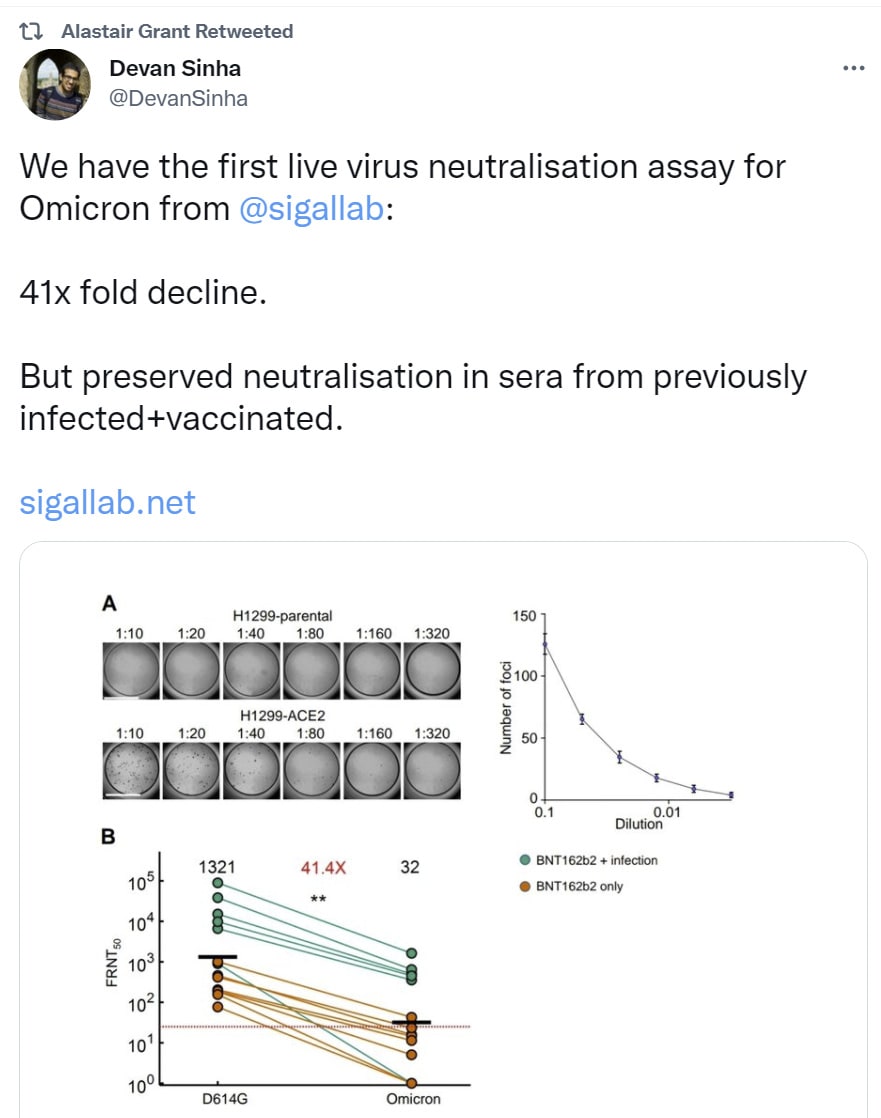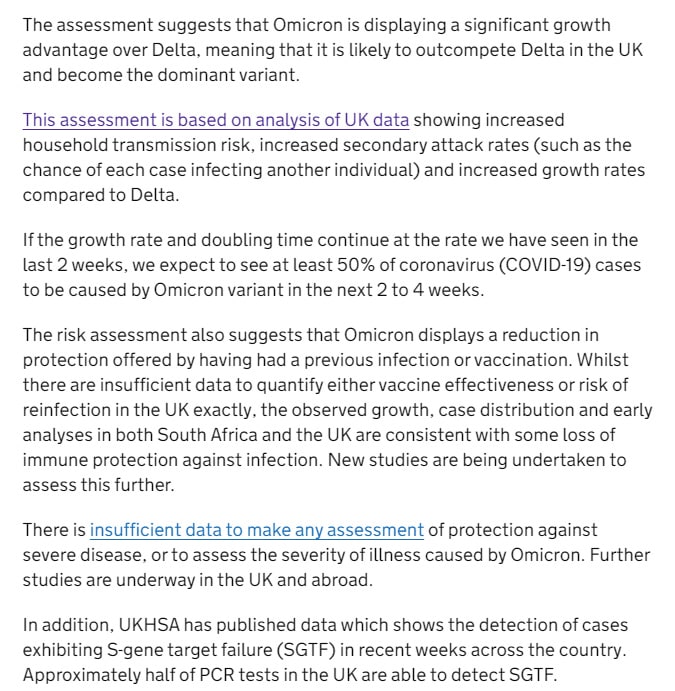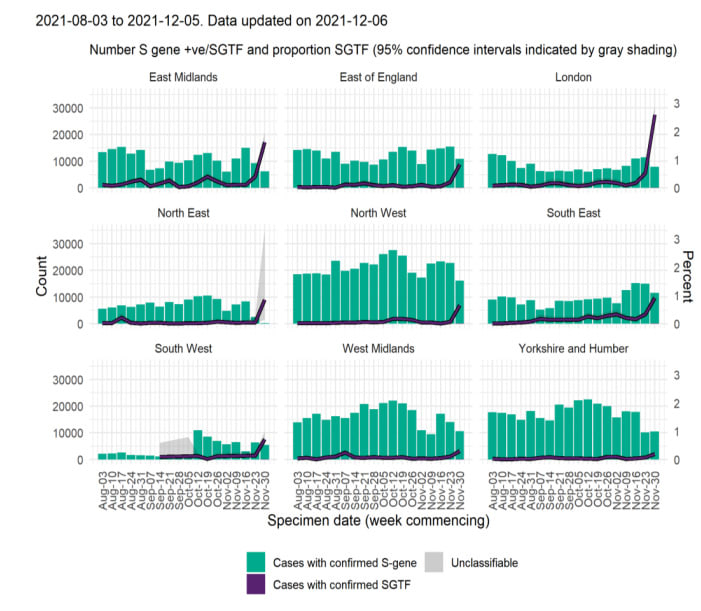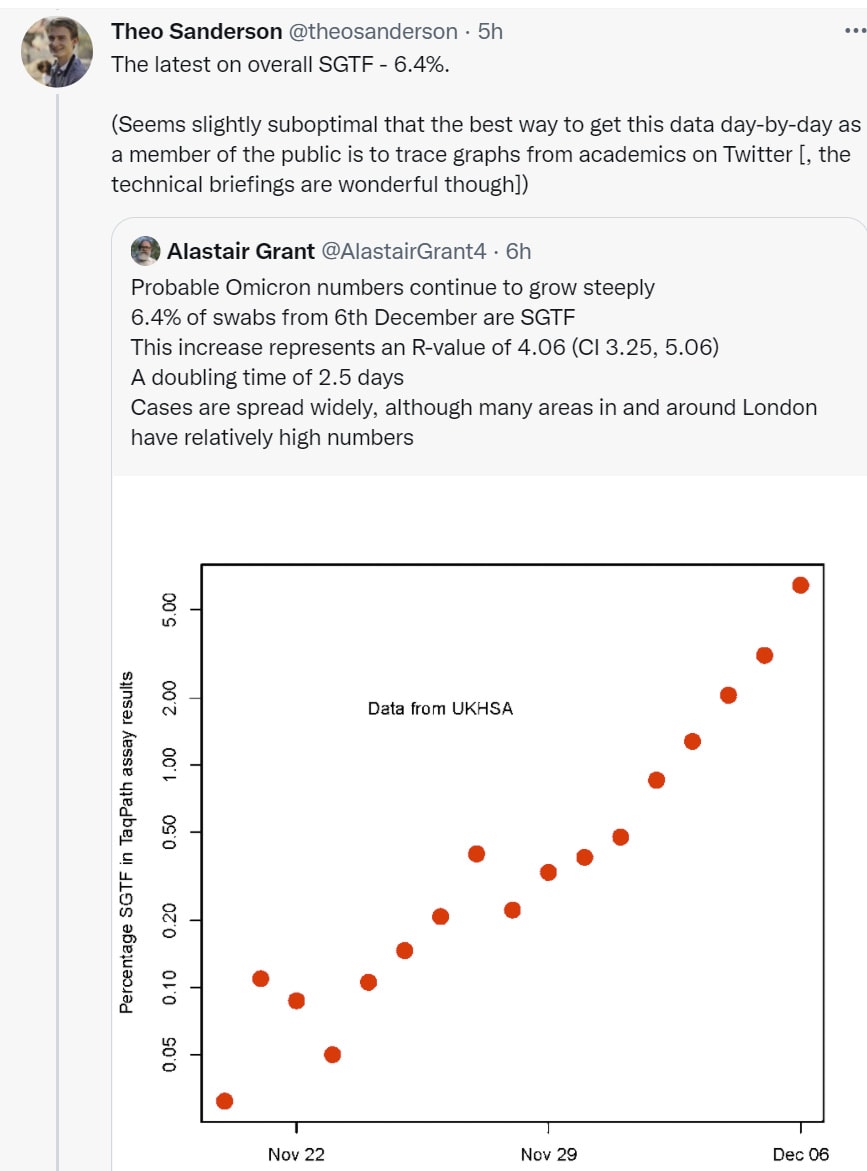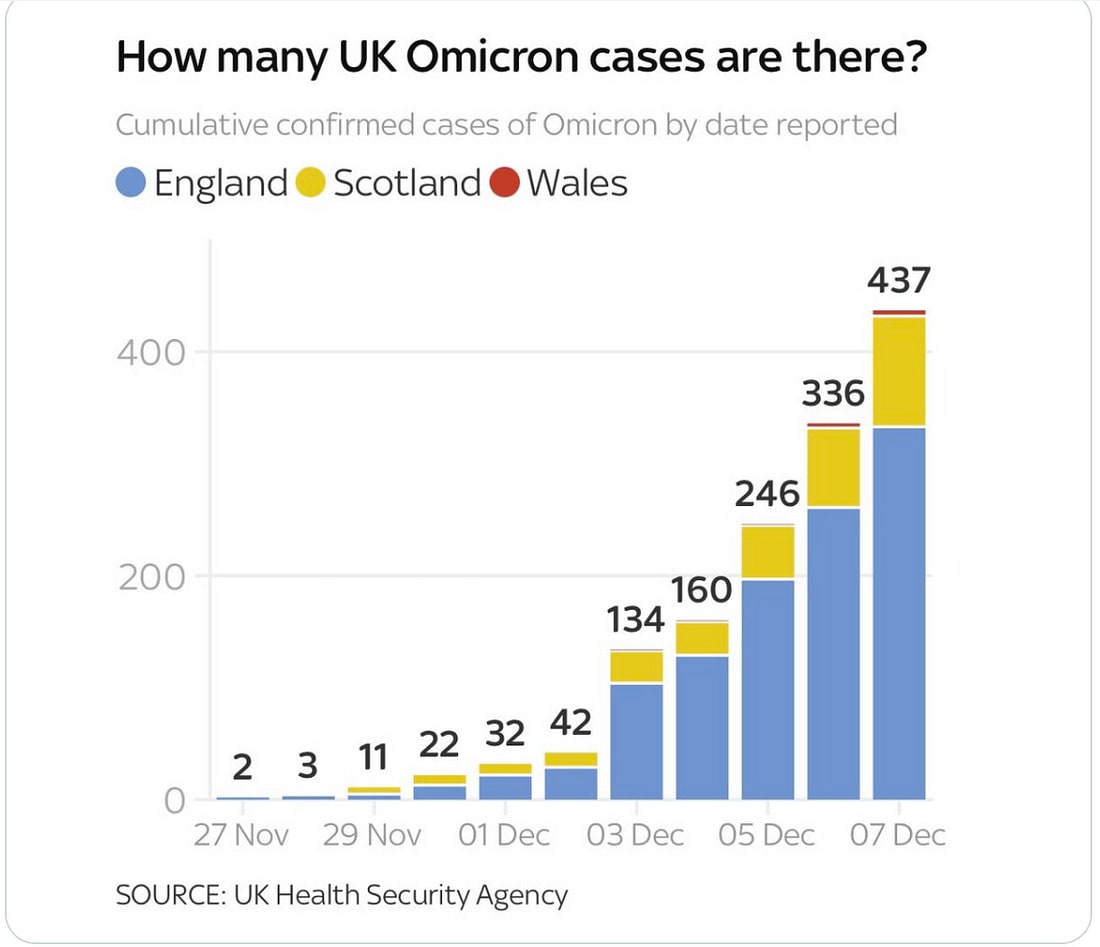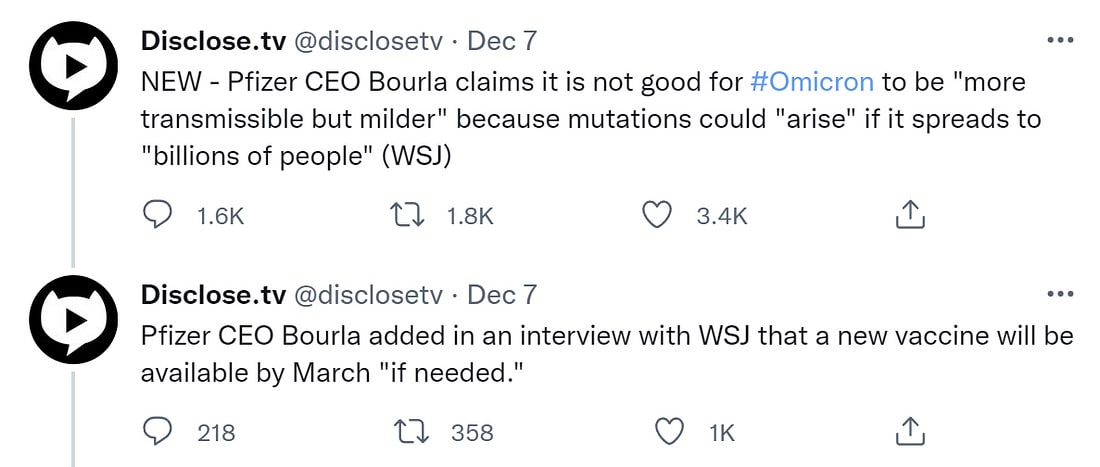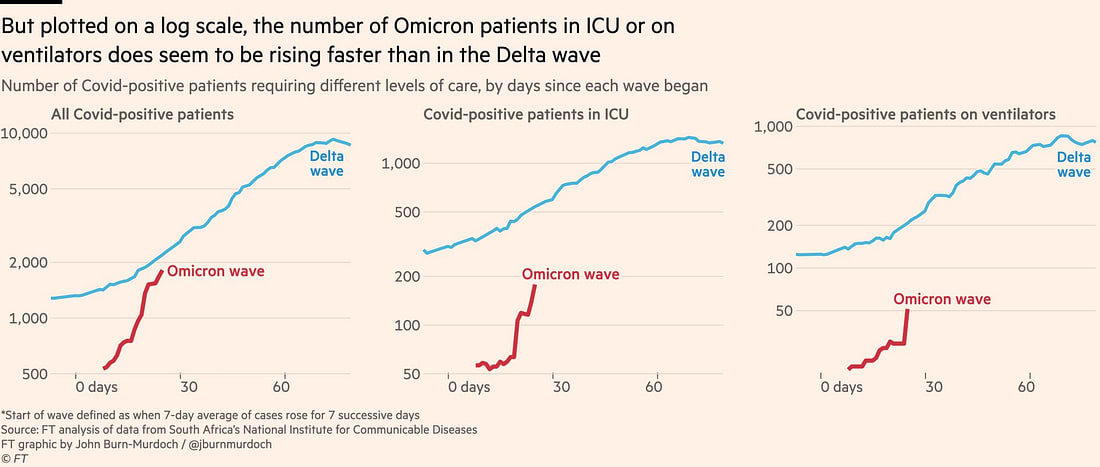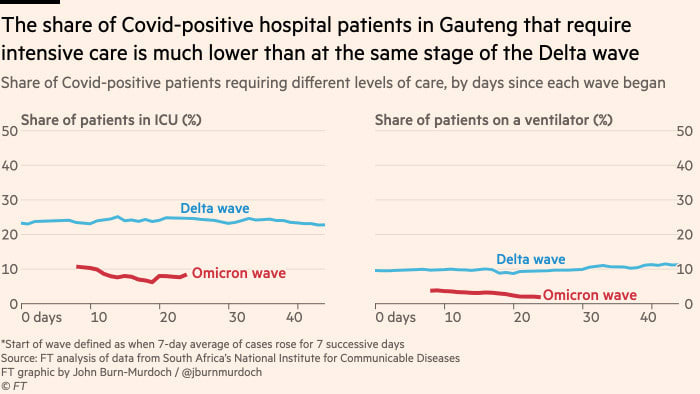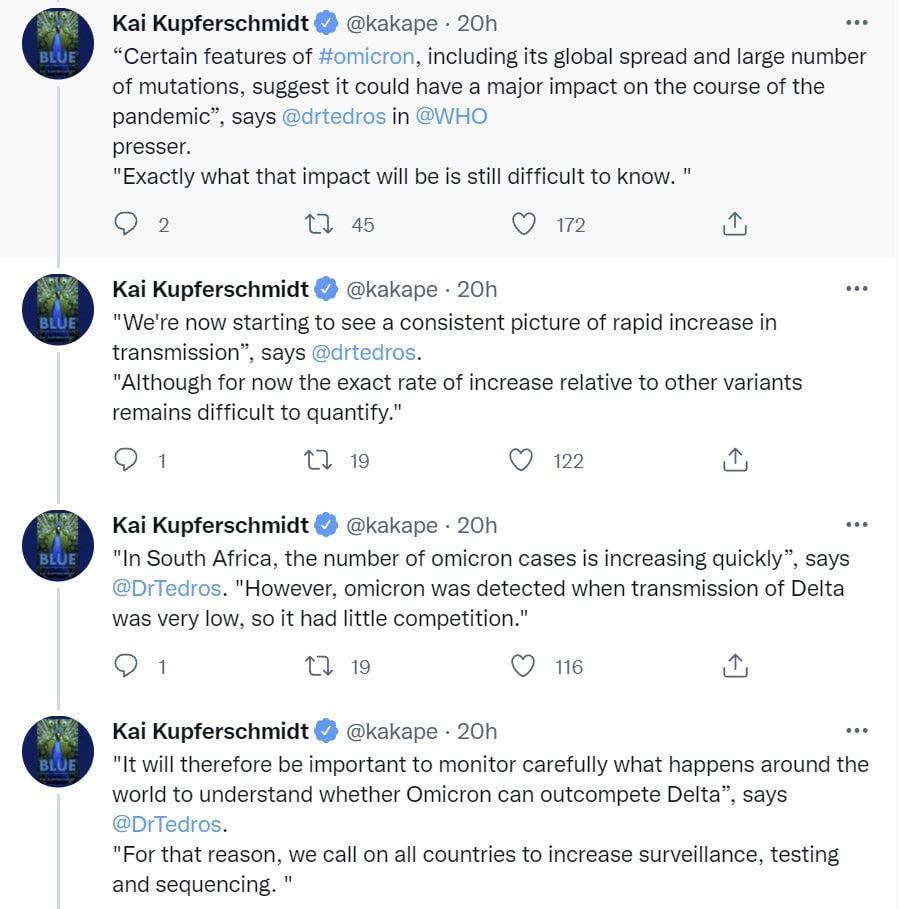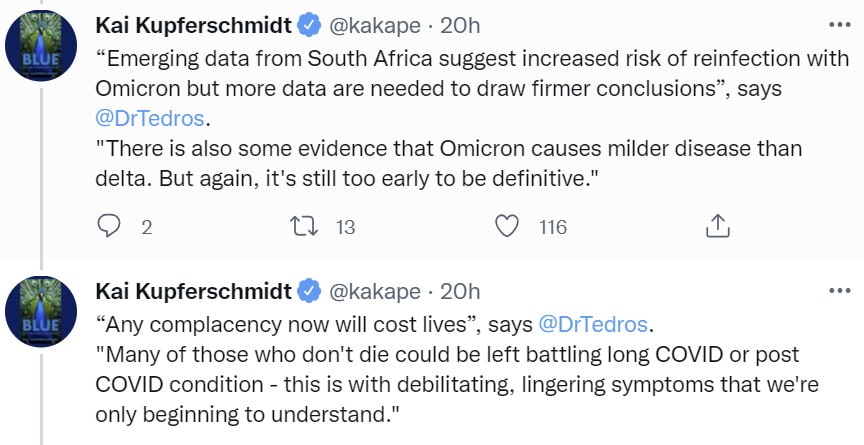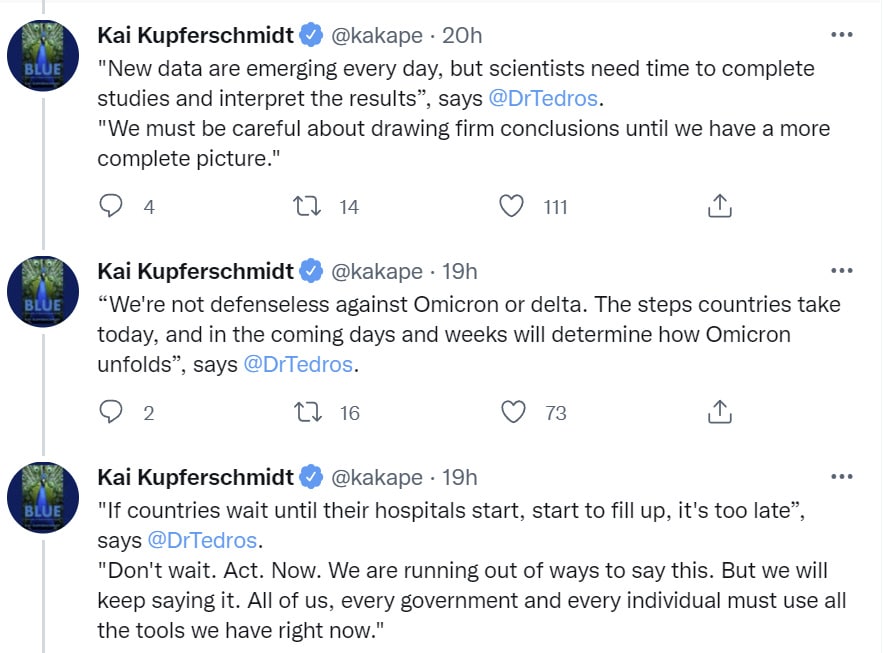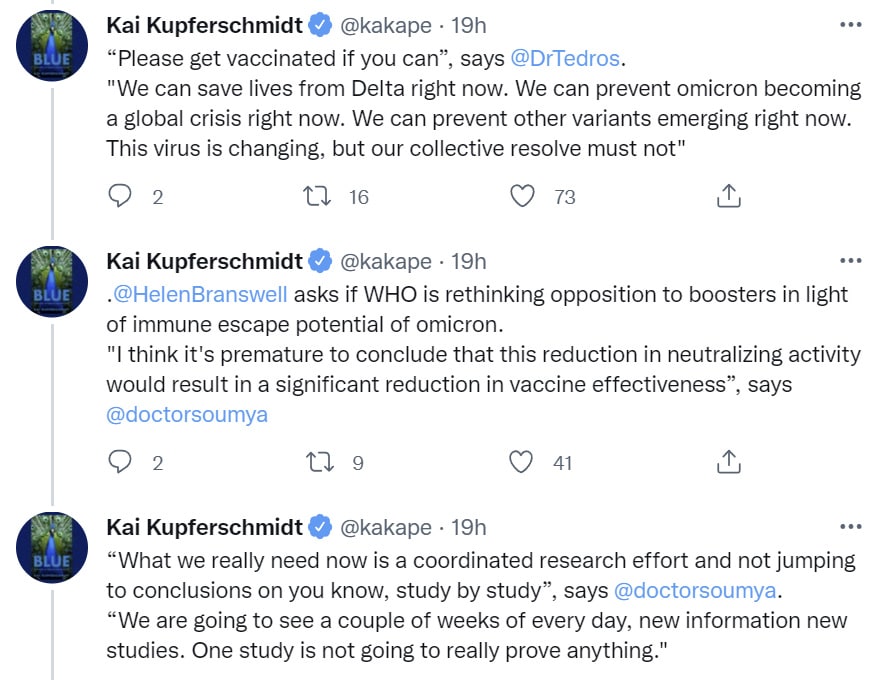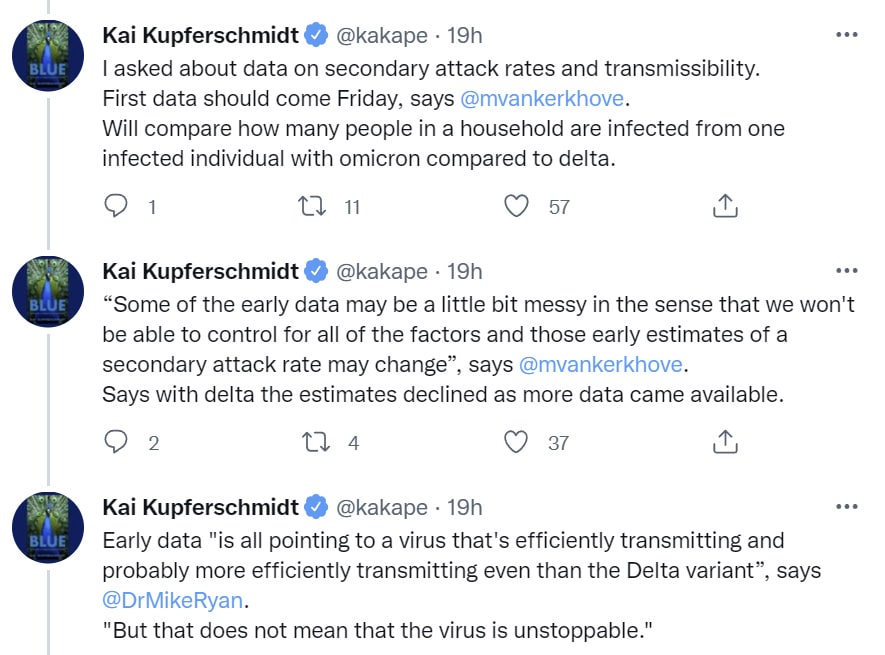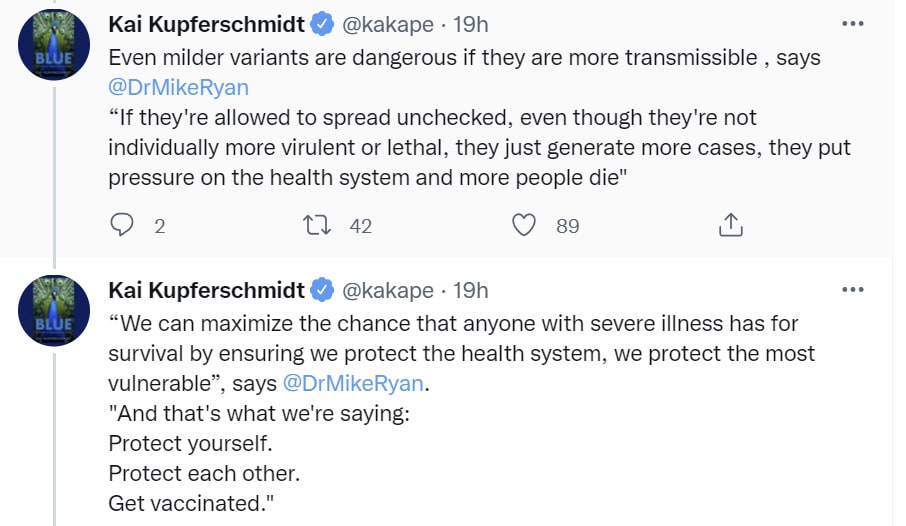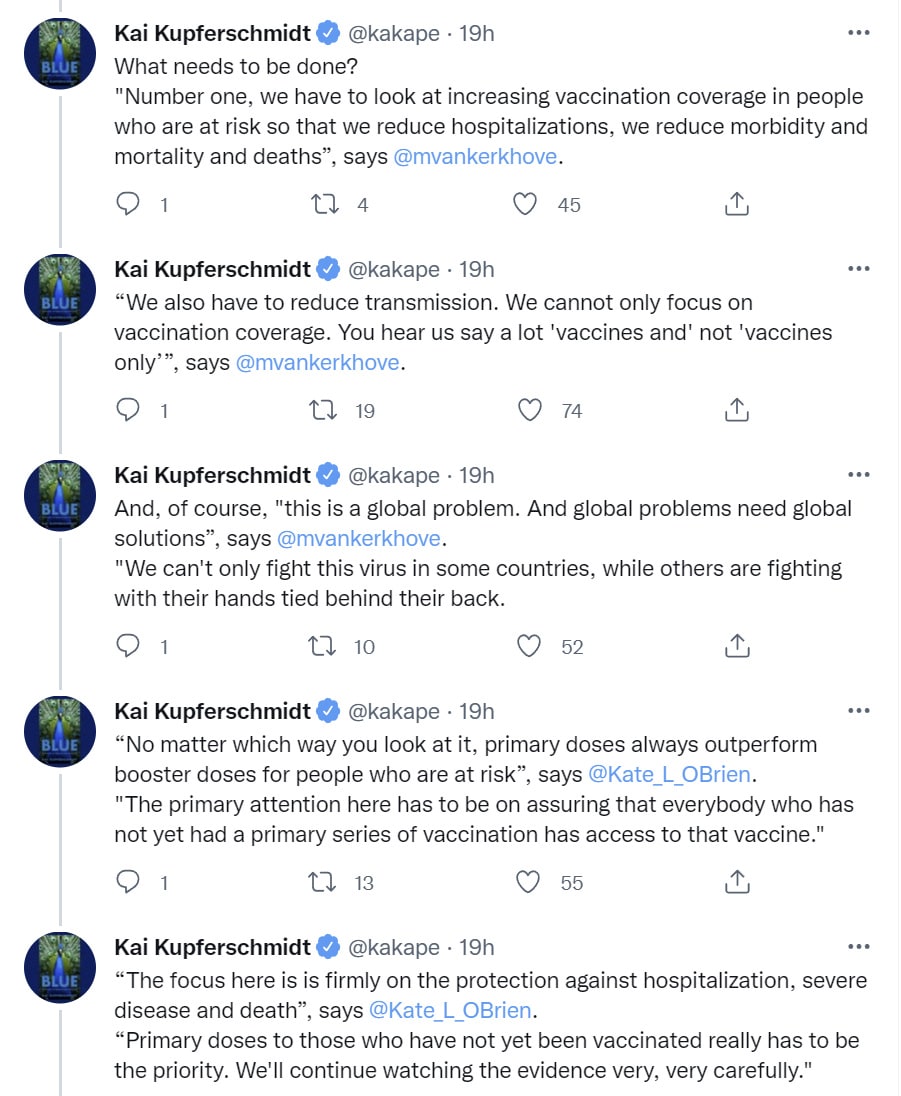102
Omicron Post #5
9Oskar Mathiasen
6Oskar Mathiasen
8tslarm
5siclabomines
4Zvi
2Daniel V
5Daniel V
3Bucky
2Zvi
3tkpwaeub
2JenniferRM
2Sammy Martin
1tkpwaeub
1hath
1NormanPerlmutter
-1denkenberger
3AnthonyC
1denkenberger
New Comment
Repost from wordpress blog
status rapport from Denmark
Key numbers: they give numbers of cases by day, and also give cases of omicron as a percentage of other cases.
Of 785 cases in Danish citizens, 76.31% of omicron cases where in double vaxed, 7.13% in triple vaxed, compared to 73.69% double (probably also including triple) vaxed for covid in general. 14.14% unvaxed for omicron 22.93% for general (over the last 7 days)
Rate of hospitalization is 1.15% for omicron (9 cases), and 1.85 in general.
Everything is probably confounded by age and region. (omicron is less prevalent in children and over 65)
sources: https://experience.arcgis.com/experience/aa41b29149f24e20a4007a0c4e13db1d/page/page_5/ https://files.ssi.dk/covid19/omikron/statusrapport/rapport-omikronvarianten-09122021-ke43
Updated numbers from today at: https://files.ssi.dk/covid19/omikron/statusrapport/rapport-omikronvarianten-10122021-ek56
Now with English translations.
Only significant change is that hospitalizations are up to 1.4% (18 cases).
There should be daily updates found her https://www.ssi.dk/aktuelt/nyheder/2021
click the newest one and click "læs rapporten her" (read the report here). Which takes you to a page where you can download the rapport for that day
Regarding the false headline ("'almost certainly' less severe"): I googled it to check the details, and it turned into a spot check of headline-writing honesty/competence among media outlets. Thankfully most went with "Omicron 'almost certainly' not more severe than Delta, says Fauci", which is what he actually said:
On the question of severity, "it almost certainly is not more severe than Delta," said Fauci.
(https://www.france24.com/en/live-news/20211207-omicron-variant-almost-certainly-not-more-severe-than-delta-fauci-tells-afp)
Can immune escape by itself explain the transmission advantage or do we also need it to be spreading better?
In theory if enough people have enough immunity you can explain any advantage with immune escape. I can't rule it out. However, I'm skeptical, primarily because if everyone was previously infected then you wouldn't see vaccines giving much advantage vs. infection (either by Omicron or Delta) or protection against severe disease. The fact that vaccines or being infected still matters vs. baseline population puts a not-too-high cap on how many people have already been infected, which in turn makes the current doubling times very hard to explain with evasion alone.
Trevor Bedford gets into this, and the short answer is technically yes, but the important part about decomposing Rt is not the decomposing it per se but the info it yields on how much vaccine escape might be going on. For reasonable R0s, there has to be substantial vaccine escape. https://twitter.com/trvrb/status/1466076797670363140
Regarding translating fold reductions of neutralization titers into vaccine effectiveness, I always go back to this: https://www.nature.com/articles/s41591-021-01377-8 (Fig 1a). Titers ~4x convalescent is what mRNAs do against wild-type, getting them to about 90%+ efficacy. About a 2x reduction against Delta means titers ~2x convalescent, getting them to about 85% efficacy. These conform with what we've seen. A 25-40x reduction against Omicron means titers .10-.16x convalescent, getting us down to 40% efficacy for two shots. Pfizer says a booster gets us back to "full" efficacy, and hopefully that holds up!
Connecting omicron and your previous post on R0, is it possible that a significant reason for the increase in effective infectiousness for omicron is that the people with higher individual R0 are now back in the susceptible population due to the significant immune erosion?
I think the default assumption is that everyone is back in the pool of potential infections, which is yet one more reason to think that it will get out of hand quickly at first.
I forgot how priceless that SNL skit was. Thanks for the excuse to re-watch it. I love when they break character - it just works.
"Are you OK, Kate?"..."Obviously I'm not"
The London School of Hygiene released a modelling paper describing some estimated effects on the UK of the Omicron wave. Mostly, it's a lot of "the error bars on all these are giant, and we don't have any clear idea what's going to happen except that there will be a giant wave of infections by mid-Jan, unclear how that translates to deaths".
If you assume no new measures and no behaviour change in the UK, you get a ridiculously enormous wave of infections that might peak with half of everyone getting infected, and that causes peak hospitalizations anywhere from 0.5-2x the UK's previous peak from the alpha wave back in January (74k additional deaths on the high end, in the not-actually-possible-even-in-principle scenario).
Again, these scenarios aren't really possible (since no behaviour change is assumed), but they are useful for getting a sense of what Omicron could be like and the likely timings of things in the UK.
What's more useful for general readers is the paper's table of assumptions about vaccine efficacy vs Omicron - this was released just after results showed VE of Pfizer + Pfizer booster against symptomatic infection is 75%,
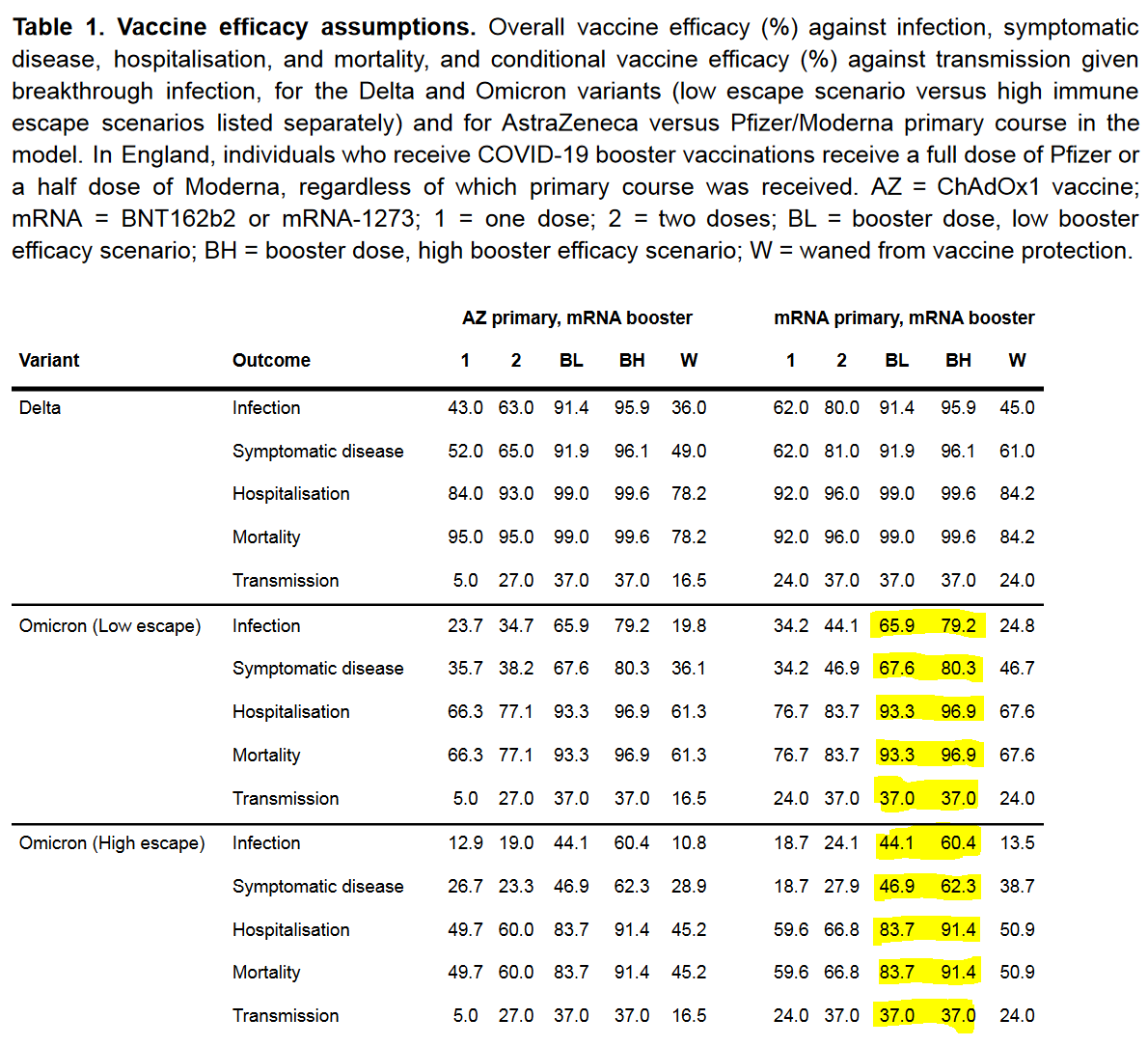
And here's the result from that Pfizer study:
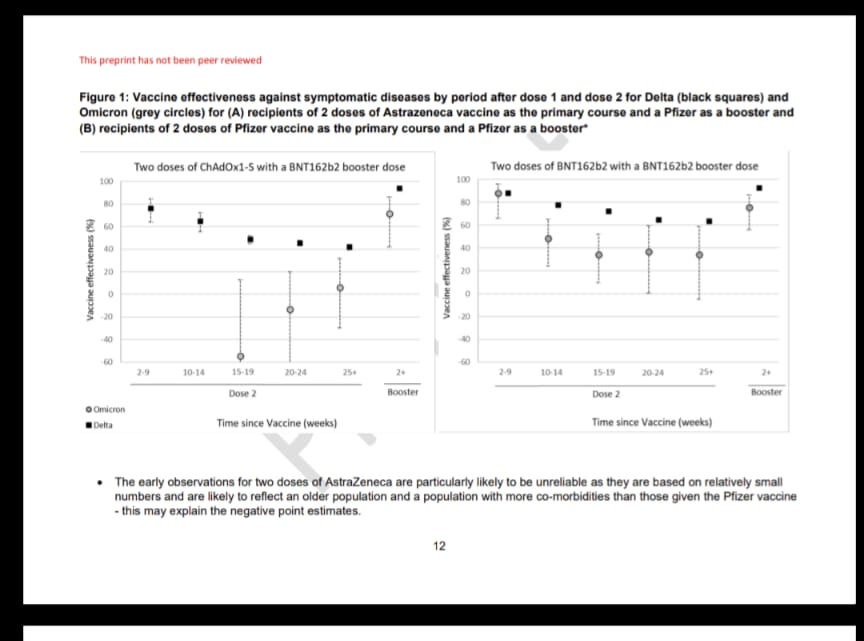
I think the paper's results are based on trying to guesstimate just what properties are reasonable/vaguely consistent with what we've seen. The highlights in yellow are the ones that will matter in the long run for most readers - efficacy for 3-dose courses on low and high assumptions about Omicron immune escape and Booster efficacy.
The range for Symptomatic Illness efficacy is 46.9 - 80.3 %, though as I said the recent Pfizer study said the efficacy was 71.4% and 75.5% protection vs. symptomatic disease for people who received AZ and Pfizer primary courses, 2 weeks post their boosters. Don't know if that means we can bias ourselves towards the upper end of that range or not (1.9, 4.0, 5.0 times lower for the low, study result, high estimates of VE vs symptomatic infection).
The range for Hospitalization/mortality efficacy for a booster is 83.7-96.9%, or a 6.1 to 32.3 -fold reduction in mortality risk vs someone who isn't vaccinated against omicron. Again, adjust accordingly based on your age, sex and health vs the UK population average. Also note this isn't taking into account Omicron being intrinsically less severe, which it might well be.
Related, some guessing about which of the evasion scenarios we're in
The lower VE numbers here might be the plausible end of a range, or might just be the authors covering all possibilities, no matter how remote or absurd.
Fingers crossed, the apparently good efficacy of a booster that wasn't intended for anything like Omicron means that it's giving you generally broad-based immunity that will work going forward against whatever next crazy variant evolution throws at us.
I keep seeing extremely hard-to-judge theories thrown around, generally by suspicious types, about vaccine-granted antibodies being uniquely brittle and setting us up for the emergence of immune evasive variants - for example here. Dominic Cummings recently alluded to a similar idea - vaccines only targeting the spike protein (even though that was the best way to make a highly effective vaccine), means variant evolution can more easily evade vaccine antibodies than if they were broader.
AFAIK this is something that was considered during vaccine development (the reasoning was that there's fewer possible ways for the spike to change while keeping the covid virus still functioning, so targeting the spike would hopefully work against future variants), but which is in principle a problem for the future. Obvious caveat - you still get T-cell immunity no matter what's going on with the antibodies, which is the underlying reason why all the assumptions in the above table are high for severe disease immunity, and since we'll eventually end up in a scenario where most of the world has T-cell immunity to Covid from vaccines or infection, that will put a limit on the damage future waves can cause
It will be interesting to see how Evusheld fits into the vaccine mandate "ecosystem" especially in Europe where they make allowance for natural immunity despite having broader mandates.
Fantastic post, as always. Possible typos:
Is Omicron Going To Become the Primary Strain? Barring a new strain, 95% → 97%. ...
Chance that Omicron will displace Delta as most common strain: 95% → 96%.
and
We continue to have to [no] reason to suspect this, so I’m going to stop worrying about it.
The 97% was in case there was no other strain that comes in. So maybe the 96% is even taking into account another new strain? Or maybe it was just a typo.
Great work!
The thing is, at some point it does mean the virus is unstoppable, in the sense that no reasonable or worthwhile attempt to stop it has any chance of success, outside of at most protecting particular vulnerable groups and doing mitigation. If the baseline transmission is higher than Delta and it’s mostly ignoring vaccinations, what is your plan exactly? Lock down much harder than we did in 2020? Close the grocery stores?
Naïve calculation: if surgical masks blocked 75% of aerosols going out and coming in, and if all transmission were through aerosols, and if people wore these masks all the time, this could theoretically overcome R0 = 16 (because the transmission would be reduced a factor of four in both steps). Of course it will not work out this well, but then there are many other measures that can be taken in addition. So I think it would be technically feasible to keep it under control. But if it were to run quickly through most of the population, omicron would have to be much less severe than other variants to not overwhelm hospitals (without massive scale up of treatments).
Masks work by reducing the fraction of virus particles from an infected individual that get into the air, or the fraction in the air that get into the wearer. My understanding is that this isn't a direct multiplier on R0, it's a multiplier on how long (on average) you need to be around an infected person, or a concentration of aerosolized virus particles, before you've accumulated enough exposure to become infected yourself. Unmasked, with no immunity, the relevant exposure times (as measured early in the pandemic) were on the order of 15 minutes. Good masks for both parties would get you into the range of a few hours. Not sure how that changes with the newer and more infectious strains, but I assume the times are shorter. But basically, my take has been that if you're going to be around someone for more than a few hours (like your coworkers or classmates), then unless you're wearing N95 masks near-perfectly, it's unlikely they're going to accomplish much. Not literally nothing, but much less than they do for brief encounters.
It's hard to pin down a threshold of a specific time of exposure because it depends on the minimum infectious dose, which varies widely among people, at least for lots of diseases. Also, the rate of shedding varies widely based on the progression of the disease, whether the person is talking, how far away the person is, etc. Furthermore, the HVAC system causes additional variation. So I think when you add all these uncertainties, a 16 times reduction in emission/inhalation would correspond to very roughly a 16 times reduction in infection, but I would be very interested to see if someone has run the math on this.
